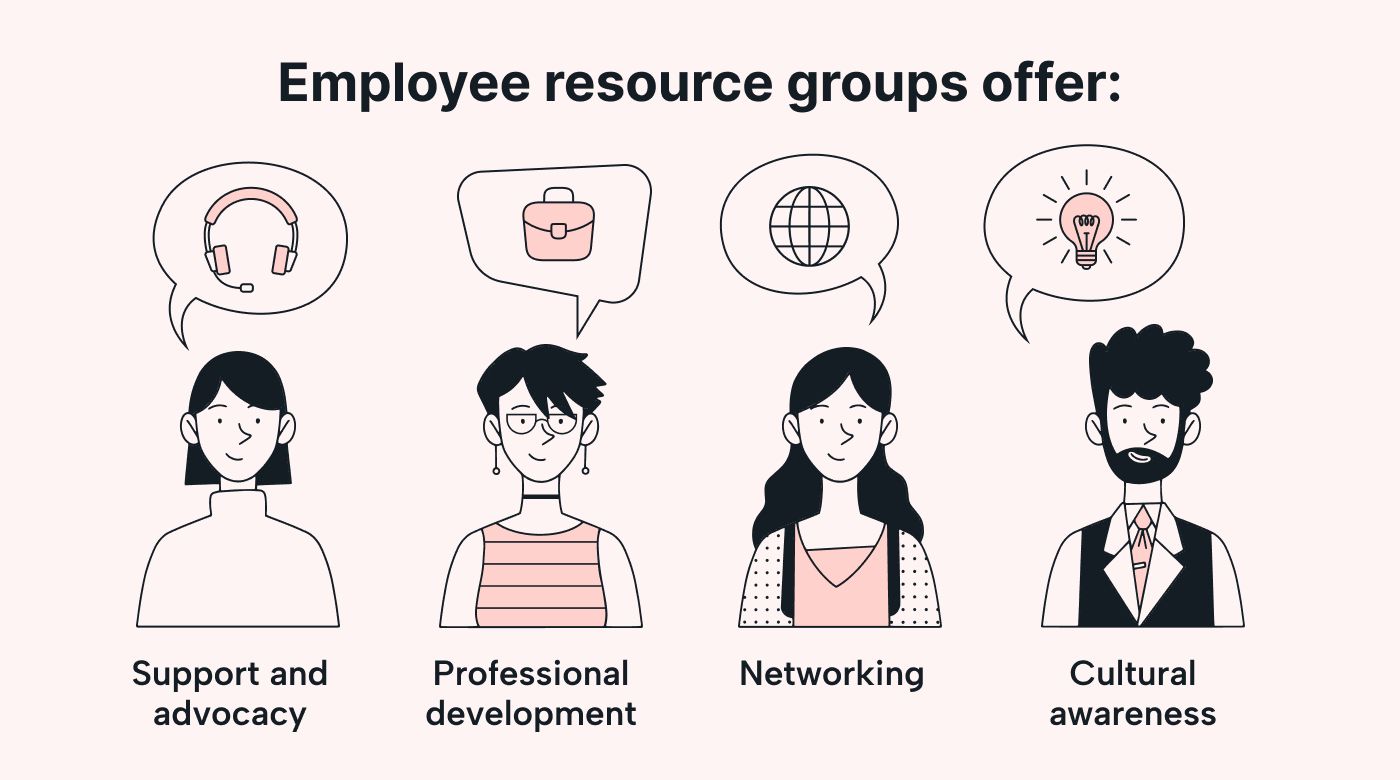By Theresa Bontempo
Creating a positive workplace environment for your staff is essential to keep them happy and prevent a high turnover rate and break away from the constant struggle to keep and train good employees. Sometimes employee evaluations and encouragement aren’t enough for some staff and instead they would feel more comfortable and feel a sense of belonging in groups with people they can identify with that have common interests and backgrounds.
Affinity groups and employee resource groups are great to implement and encourage staff to start and participate in. These employee-run groups can both align with company policies and regulations, plus give staff another outlet when they need extra support with a group of people that share the same ethnicity, race, religion, interests, and backgrounds.
It’s important to know the differences between affinity groups and employee resource groups as well as how they can improve any workplace environment to have happier, more supported staff!
Affinity Groups: The Informal Group With the Most Support
Although affinity groups are less formal than employee resource groups, they still have the same lasting effect for employees!

Affinity groups can provide a sense of community and belonging for those from similar backgrounds and interests on a less formal basis. Image courtesy of SHRM.
Learning about how both affinity groups and employee resource groups can benefit a business is essential to see if they’re worth implementing within your own. Keeping happy staff is important and with little things such as affinity groups, they can be the resource that many employees need to make changes within the company.
What Are Affinity Groups?
Affinity groups and employee resource groups are very similar, and it can be hard to differentiate the two. With affinity groups, they bring together groups of people that share similar backgrounds–which can include race, ethnicity, social backgrounds, sexuality, and interests. These groups are more informal as they aren’t recognized by the company and can be run outside of it with less structure--but they can still work to achieve higher employee retention, show an increase in job performance, and even a reduction in sick days.
Often centered around the same personal identities and interests, affinity groups are employee-run and they can hold meetings and social get-togethers for staff to create a community and safe space for like-minded individuals. Specific affinity groups can gather and help each other with personal career development, develop cultural awareness, and offer support both inside and outside of the workplace.
Common Affinity Groups Staff Establish
Affinity groups that many staff members can join often reflect their daily life, race, sexuality, or gender. These are among some of the most popular affinity groups that are started that can bring the support many staff need:
- Women in the workplace
- LGBTQIA+
- Racial and ethnic groups
- Veterans
- Generational age groups
- People with disabilities
- Religion
- Working parents
- Physical and mental health well-being
- First-generation professionals (first in family to attend college)
Benefits of Affinity Groups
There are a number of affinity groups that can bring a lot to the table even if they are operated outside of business hours and are less formal in structure. Some of the benefits of starting an affinity group within any business can show improvement in the following areas:
- Improves mental health by creating a community for similar groups of people
- Can increase professional development with mentoring opportunities and shared knowledge
- Can influence organizational leaders within the company with positive ideas
- Creates a community for belonging where staff can support each other
- Work together to advocate for change within the company and society
- Develop connections and relationships with staff members
- Increases employee engagement and retention rates
- Increases professional networking
Employee Resource Groups: Company-Regionized with Established DEI Requirements
These groups follow a structure and can be recognized by the company with their backed-up support!

Employee resource groups offer support for staff and follow a structured routine of meetings, cultural celebrations, and DEI standards. Image courtesy of Motion.
Similar to affinity groups are employee resource groups that can do a lot of good for a company and its staff. These tend to be more professional and structurally-sound groups with more routine than an affinity group, but the mission goals of both remain the same with many staff feeling more at home once they join one.
Employee Resource Groups and What They Are
Over the years, diversity, equity, and inclusion (DEI) has been established and implemented in many companies to help hire staff that come from many backgrounds to create a comfortable workplace environment for everyone. Employee resource groups are a great consideration to implement for many groups of people within a company because they create a supportive and safe community for everyone, along with empowering staff.
Employee resource groups are similar to affinity groups–just with a little bit more structure and are recognized and financially supported by the company they are a part of. Once again, these are employee-run groups representing certain groups of people ranging from race, ethnicity, sexuality, gender, interests, and other similar backgrounds to create a community and support for those who need it. Employees that start these resource groups are responsible for organizing a set schedule of group activities and planning special events that pertain to the specific common ground or interest of the group. These groups all have one main goal–to remain supportive towards members, their personal experiences, and allow them to have a voice.
These groups can oftentimes be confused with affinity groups because they can essentially be the same groups for the same types of people, but the difference is that ERGs are backed up by the company.
How Do Companies Play a Part in Employee Resource Groups?
These groups are typically run by staff or members of the company’s HR department and they can also receive executive sponsorship. Senior leaders of the company can act as sponsors and provide resources without taking over the group, leaving it up to the employees as to the activities and meetings they have. The company can also provide budgets, software, and other tools to help lead the ERG group to be overall beneficial to the company and create happy staff members.
Benefits of Employee Resource Groups
Just like affinity groups, employee resource groups have similar benefits that can help staff feel more welcome in the workplace, their societal issues be heard, and gain the support of people that have similar backgrounds as them. Some of the benefits of employee resource groups that can help both staff and the companies they work for include:
- Increase employee engagement and retention
- Creates a sense of community for every group of people
- Builds feedback loops to provide insight for companies as to how employees are feeling and thriving in their career
- Empowers employees to make internal changes in the company (flexible pay, paternal leave, etc.)
- Career development with workshops, seminars, and trainings
- More DEI initiatives to serve multiple groups of people within the workplace
- Improves employee recruitment
- Expands creativity and productivity within staff members
Strategies for Engaging Affinity and Employee Resource Groups
Having both affinity and employee resource groups work together can be a great benefit on overall company retention and satisfaction!

Affinity and employee resource groups have the same mission–to support staff and underrepresented groups while in the workplace. Image courtesy of The Diversity Movement.
With an understanding of the similarities and differences of both affinity groups and employee resource groups, there are many ways to bring them together to further benefit staff and spread awareness for underrepresented groups of people. With two forces coming and working together, strategies can impact any company on a larger scale to implement change and equal opportunities for everyone.
Prepare and Present Joint Events
Since many subgroups of both affinity and employee resource groups are the same–just on different levels of influence and power–they can strategize and coordinate joint events to work together to further continue to make an impact on their company and let their voices be heard. These events can help to reach a broader audience within the company, such as two different groups working together to explore shared experiences can gain more insight into acceptance and how we all can efficiently work together.
For example, a black woman that is a part of an affinity group for women in the workplace can work together with a black American employee resource group to offer shared experiences that can pertain to both groups and gain more insight into others’ struggles too.
Attend Cultural Celebrations Together
Groups of similar backgrounds for both affinity and employee resource groups can work together to schedule or attend cultural celebrations together. Different celebrations during specific heritage months can be a great option to attend or schedule, such as Black History Month or Hispanic Heritage Month, or religious and cultural festivals such as Christmas, Yom Kippur, or the Lunar New Year.
With cultural celebrations and presentations to attend, it can help to foster a deeper appreciation for diversity and strengthen the community around both these specific affinity and employee resource groups. Even for outside groups, working together and attending these events can foster empathy and respect for underrepresented groups..
Encourage Allies From Other Groups to Attend Meetings or Events
There are many people that may not identify with affinity or employee resource groups, but they can find sympathy and be an ally for them. Encouraging allies of other groups to attend meetings and events can be another efficient way to strategize change through both affinity and employee resource groups working together.
This can consist of the creation of events for allies to come attend and learn more about the missions of these other groups to help foster support and understanding from them. It can be a great way to understand the struggles that other groups of people go through that you may not be familiar with, which can help shed light on them.
It should also be noted and clear that allies are allowed and welcome to attend these events despite other groups they may be a part of.
Go to Trainings, Work Events, and Fundraisers for Further Support
Gaining support from the people within your company, including those in higher up positions is crucial from any affinity or employee resource group. Since these different groups can all work together in the same building professionally, you can attend training, work events, or donate to each other in different fundraisers to gain traction and support from one another.
Affinity groups don’t receive the same type of fundraising that many employee resource groups do–so for example, members of ERGs can attend affinity group fundraisers to gain their support and also be recognized more from the company too. It can help them to gain more members, discuss shared experiences, and why individuals feel it's a safe space for them.
Even doing something as attending training and work events can get different members of both of these types of groups speaking, form deeper connections, and potentially make plans on how they can work together to make essential changes company-wide.
Affinity Groups vs. Employee Resource Groups: The Same Mission for Change in the Workplace
While both affinity and employee resource groups are slightly different in terms of company support, they have the same mission–to empower individuals with similar backgrounds, spread cultural awareness, and make a change. Making changes within society can be tough, but affinity and employee resource groups can start small by impacting their own place of work to ensure that everyone has the same equal opportunities despite the color of their skin, gender, sexuality, or upbringing.
Consider bringing together both affinity and employee resource groups and strategizing ways both groups can come together to be the change in any company to create a positive work environment for current and future staff!
Also, check out Shift–a content management system–that can be easily paired with digital signage to help organize and make your affinity and employee resource groups run smoother and be more interactive than ever before!
















